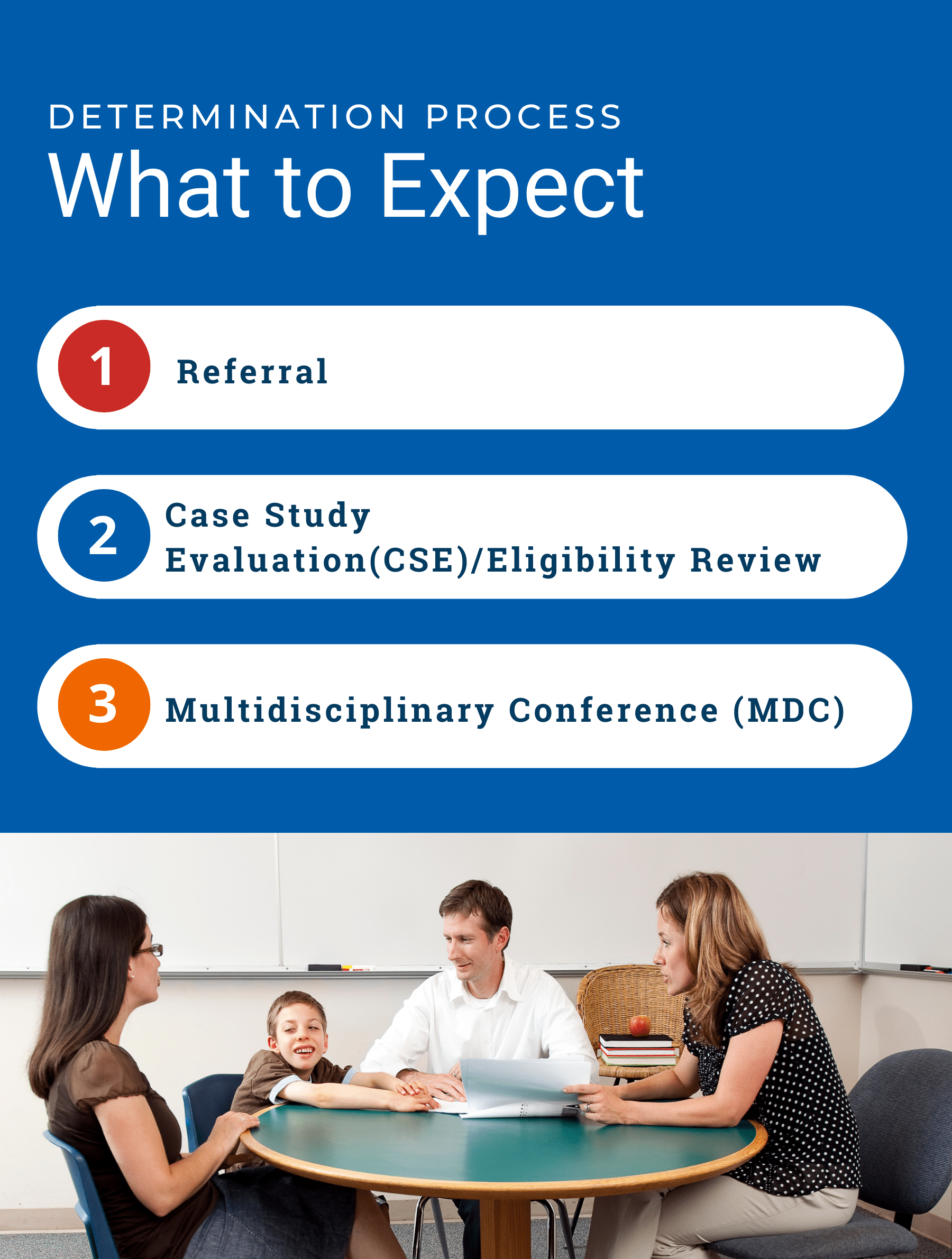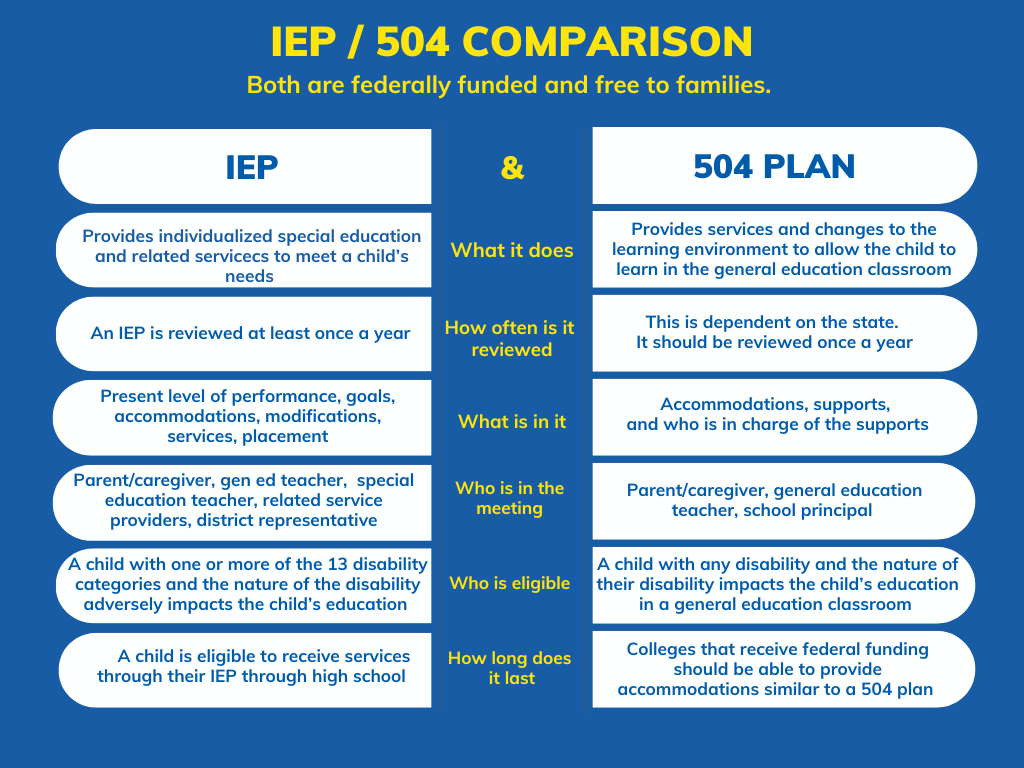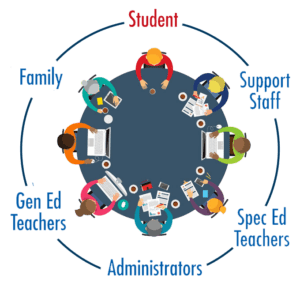Individualized Education Plan (IEP) & 504 Plan
One of the most important education decisions you and your child’s school team will make is if your child should have an IEP or a 504 Plan. At its simplest definition, an IEP provides services to your deaf and hard of hearing child while they are in school, such as speech therapy, a hearing itinerant, and an ASL interpreter to name a few and a 504 Plan provides accommodations, such as seat placement in the classroom, the teacher using Bluetooth technology to support your child, and written instructions for lessons. In this section, we wanted to take you through the process, so you know what to expect and are better able to advocate for your child. As this is a collaborative process between the family and the school administration, we dive deep into the two learning plans. We want to make sure you know your child’s rights, what questions you will be asked and what you can request during your meetings, so we curated crucial information allowing you to be the best advocate for your child during the learning plan meeting.

Transitions when your child turns 3
When your child turns three years of age, they are no longer eligible to receive Early Intervention services and transition to special education services provided by the local school district. Each child is unique and their language, academic, and social-emotional needs will vary. Thus, the resulting schooling will vary as well. Your service coordinator will work with you to transition your child into your public school system by setting up an evaluation of your child’s needs that will result in either an IEP or 504 Plan or determine if no accommodations are necessary. Placement decisions should be based on the needs and services as identified in the meeting, not based on location or expenses. The process of developing this 504 or IEP programming to support your child can be time-consuming and overwhelming.
The first step is to determine if your child qualifies for special education services through your local school district. The IDEA has several steps that must be followed, regardless of where you live. Each step is explained in this chart:
“Having an IEP has enabled my daughter, who wears bilateral cochlear implants, to receive the services and accommodations she needs to be successful in a mainstream classroom. Through her IEP, she has access to weekly services with a hearing itinerant, which not only addresses her language and communication needs, but also ensures her educational performance is consistently being monitored as it relates to her hearing loss. This has allowed us on more than one occasion to quickly identify changes in my daughter’s hearing and engage her audiologist to adjust her MAP and optimize her access to sound. Her IEP also requires her teachers to use hearing assistive technology that links to her cochlear implants and addresses her environmental needs through planned seating and acoustic modifications.”


THE DETERMINATION PROCESS
Referral:
What is a referral and who makes them ?
A referral means sending a written request to the school district asking that a child be evaluated to determine if the child is eligible for special education services.
If your child receives Early Intervention Services your Service Coordinator will initiate the referral. If you have not had early intervention, you have the right to request that the school district evaluate your child and give them permission to do a case study evaluation of your child. Keep a copy of the written request at home.
Also, your child’s teacher, a community service agency or any professional can make the referral.
Making a referral does not mean your child has a disability. The goal of a referral is to find out if your child has a disability and needs special education services. Once a district receives a referral request, they have 14 days to determine if they will conduct an evaluation. If they determine, they will hold a meeting to determine what assessments will be completed.
Assessment/Eligibility Review
After the referral is made, tests and evaluations are done with your child to see if your child has a disability and requires assistance in school. These assessments can be in the areas of academic achievement, functional performance, cognitive functioning, communicative status, health, hearing/vision, motor abilities and social/emotional status/social functioning.
- Once the referral is made, the school district has 60 school days to complete the review.
- The review must not be biased against your child’s race or culture.
- The review must be done in your child’s language
Eligibility Meeting
After the assessments are completed, there must be a meeting with the parents, school district, and all the people who did the review on the child. This meeting is called the Eligibility meeting. Parents/Guardians must receive copies of the draft evaluations at least 3 school days prior to the eligibility meeting. At the meeting, the team will look at the review results and decide if your child is eligible for special education and has a disability. If the team determines that your child is eligible for special education and has a disability, they can start the IEP process.
If you don’t agree with the results from the Eligibility Review, you have the right to ask for an independent educational evaluation (IEE). The school should be able to provide you resources for the IEE.
Even if your child does not qualify for special education services under IDEA, your child may be able to get help under another federal law called Section 504 of the Rehabilitation Act of 1973 And under the protection of the ADA.
Individuals with Disabilities Education Act (IDEA) is the law that governs both early intervention services and special education services, provides you and your child with the following rights:
- A free and appropriate public education, regardless of disability.
- The State of Illinois can use Medicaid to pay for your child’s services at school, but they cannot use your private insurance unless you agree.
- If your child receives special education services, you must be given written notice within a reasonable time before any meetings, and before any service your child receives is changed or denied. This notice must explain the procedures, the meeting or the proposed changes, and inform you of your rights.
Ultimately, it is important to remember that your child has the right to a FREE and APPROPRIATE public education AT NO COST to you. This education should mirror the education that any child would receive, and includes reading, writing, math, science, social studies, art, music, gym, library as well as other opportunities readily available within public schools. Since your child is deaf or hard of hearing, you must work with the school district to ensure that their language, academic, and social needs are being met so that they can learn and succeed.
Section 504 of the Rehabilitation Act of 1973 Individuals and the Americans with Disabilities Act (ADA) are major federal legislative acts that are designed to protect the civil rights of individuals with disabilities. The intent of these two laws is to prevent any form of discrimination against individuals with disabilities who are otherwise qualified.
Section 504 applies to entities that receive federal funds, and the ADA applies to virtually every entity except churches and private clubs.
Schools must afford students with disabilities with equal opportunities “to obtain the same result, to gain the same benefit, or to reach the same level of achievement” as students without disabilities. Section 504 applies only to entities that receive federal funds. Most public schools receive substantial federal funds through their participation in various federally supported activities, and as a result, they must comply with the provisions of Section 504.
In general, schools must do numerous things to meet the requirements of Section 504 and the ADA. For the most part, these actions are based on common sense and treating individuals with disabilities fairly. If schools approach the implementation of Section 504 and the ADA using these guidelines, then most instances of potential discrimination can be dealt with simply and without a great deal of expense. The Office of Civil Rights (OCR; 1989a) described the following specific requirements for schools regarding Section 504:
- Undertake annually to identify and locate all children with disabilities who are unserved;
- Provide a “free appropriate public education” to each student with disabilities, regardless of the nature or severity of the disability. This means providing regular or special education and related aids and services designed to meet the individual educational needs of disabled persons as adequately as the needs of nondisabled persons are met; Ensure that each student with disabilities is educated with nondisabled students to the maximum extent appropriate;
- Establish nondiscriminatory evaluation and placement procedures to avoid the inappropriate education that may result from the misclassification or misplacement of students;
Establish procedural safeguards to enable parents and guardians to participate meaningfully in decisions regarding the evaluation and placement of their children; and - Afford children with disabilities an equal opportunity to participate in nonacademic and extra-curricular services and activities.

New Parent Resource Downloads Now Available!
Developed by Dr. Anna Tess, our Education Coordinator, our Education Resources deliver valuable insights and information. All downloads are available in English and Spanish.
- The Parent Resource Guide has information about parent rights, the IEP process, accommodations and modifications for children with hearing loss, and 504 plans.
- The Early Literacy Guide provides strategies and information to help you read with your child.
- Additional resources include Milestones and Deaf with Disability.
THE DIFFERENCE BETWEEN AN IEP AND A 504 PLAN
IEP
An Individualized Education Plan (IEP) is guided by the Individuals with Disabilities Education Act (IDEA). An IEP provides special education and related services to a student who is identified as having a disability that negatively impacts their ability to receive academic instruction like a hearing impairment. This plan entitles a student to a modified curriculum, classroom accommodations, specialized instruction, and related services such as occupational therapy, physical therapy, speech therapy and/or counseling.
Students with an IEP are re-evaluated every three years to determine continued eligibility. However, a parent can request a re-evaluation sooner than three years, but not less than one year, and all IEPs are reviewed annually.
504 PLAN
A 504 Accommodation Plan is guided by the Americans with Disabilities Act (ADA) to ensure that a student with a disability has access to accommodations that improve academic functioning in the general education classroom. In order to qualify for a 504 Plan, a student must have a diagnosis of a “qualifying disability that substantially limits a major life activity”.
A 504 Accommodation Plan can provide extended time or small group administration for statewide testing, and it can allow for accommodations like frequent breaks, preferential seating, or modified homework assignments.
Note that a student is not able to receive specialized instruction or related services, such as occupational therapy, speech therapy or physical therapy – through a 504 Accommodation Plan.

THE IMPORTANCE OF AN IEP
A carefully crafted IEP has the potential to give your child what they need to succeed in the classroom. IEPs provide a legal record that documents how your child’s academic and other needs within a school setting are met. As a part of the IEP team, the parents’ input is crucial for helping the team create a plan that addresses all of the student’s needs. Unlike a 504 which merely accommodates, an IEP creates a plan to address and overcome learning challenges.
An IEP is especially important during changes in the student’s academics, teachers, school setting, health, or other needs. It ensures a student’s rights and is protected under the individuals with Disabilities Education Act.
A GOOD IEP SHOULD INCLUDE:
Present Levels of Performance (PLP):
This is a summary that describes current specific, measurable, objective baseline information for each area affected by the disability as well as the child’s strengths and challenges.
Goals:
These are descriptions of what a student can reasonably be expected to accomplish within a 12-month period with the provision of special education services. Goals should be SMART: Specific, Measurable, Achievable Results, Time-limited.
Accommodations and Modifications:
These are the supports in place to help the child succeed with their IEP goals and in the classroom. These may include a remote microphone, extended time, repetition of directions and preferential seating.
Assistive Technology (AT)
Every IEP must consider technology programs, services, or devices that a student must have to be successful.
Related Services:
These are services that your child might need to participate in school. Such services include but are not limited to: transportation, speech-language pathology, audiology services, psychological services, physical therapy, occupational therapy, recreation, early identification and assessment of disabilities, counseling, orientation and mobility services, medical services for diagnostic or evaluation purposes, school health services, social work services in school, and parent counseling and training.
Description of Special Education Services:
This indicates the time, frequency, and any related services that the student needs, as well as the amounts of time these services will be provided. The amount of time and areas in which the student will be removed from the general education setting are also identified.
Progress Reports:
Reports by school staff that let you know how your child is doing with the IEP goals, and show if objectives or benchmarks are being met. These reports should be given at the same time as the child gets a report card.
Least Restrictive Environment (LRE):
According to IDEA, IEPs should provide the greatest exposure to and interaction with general education students and persons without disabilities.
The first IEP meeting we went to was long and exhausting. A roomful of teachers, case workers and specialists sitting around a long table, hastily typing away at their laptops. It was really hard to focus on what my child needed help with instead of what my child does well. We had no idea what to expect. Prepare with a good breakfast and bring snacks, water and toys or books in case your child needs it.

WHO ATTENDS THE IEP MEETING

To help you participate, the school must make reasonable efforts to:
- Schedule the IEP meeting so that you can attend
- Provide an interpreter for you, if needed
- Inform you about the meeting
- Inform you of your rights
However, if you decide not to participate in writing your child’s IEP, the school can hold the IEP meeting without you.
Under IDEA, there are many people who are a part of the IEP team and each person will share their own point of view and experience. It is important to note that there doesn’t have to be a different person for every role. Often one person can carry more than one responsibility on the team.
The following team members might share the following information about your child:
The Parent(s) bring very important information to the IEP meeting. You know your child better than anyone. Your knowledge can steer the team toward creating an IEP that will work best for your child. Your job at the IEP meeting is to:
- learn and understand the process
- share information
- ask questions
- offer suggestions
- keep the team’s focus on “the big picture” and your child’s long-term needs speak up on your child’s behalf
- School Administrator or person with authority to make decisions. The Administrator at the IEP must know what resources the school has available. This person must also have the power to commit the resources needed so that services can be provided as outlined in your child’s IEP.
- The General Education Teacher – if the child participates in the general ed curriculum. They know the curriculum for your child’s grade level and what students in general education classes are typically expected to do. If your child is going to be educated in the general education classroom the teacher will spend time discussing the transition, support and expectations.
- The Deaf Education Teacher will share information about how your child learns, behaves in the classroom, interpretation of assessment results and any additional concerns and needs that will influence your child’s IEP plan. The Deaf Education Teacher may take the lead in developing your child’s goals and objectives.
- Service Provider – Any therapists that work with your child should be invited to this meeting to discuss your child’s progress, challenges and goals. Service providers may also include evaluation personnel, such as school psychologist or outside private evaluators, outside therapists or other professionals.
- Additional Personnel – Additional Personnel include translators or interpreters if needed, transition personnel (when discussing post secondary transition), and others with knowledge or special expertise about your child.
- The child – Depending on their age, your child can play an important role during the IEP meeting. It is optional for a child to attend the IEP until the age of 14, then it is required that they are invited to attend. Attendance is not required. The decision for the child to attend should be weighed very carefully in your family. Take into consideration the amount of information you feel comfortable with your child hearing about their learning needs, which will be both positive and areas that need support. Requests and suggestions that come directly from your child can carry more weight than when they voice them. Many parents are sometimes surprised when they hear their children speak about their disability, their educational desires, and their goals for the future. And sometimes teachers learn things about their students that they didn’t know before. It can be a overwhelming amount of information for you and your child to process,
HOW TO ADVOCATE FOR YOUR CHILD
- Openly discuss the goals you have for your child with school personnel.
Be familiar with the laws governing your child’s rights and your rights as a parent:
a. The Individuals with Disabilities Education Act (IDEA)
b. The Rehabilitation Act of 1973
c. The Americans with Disabilities Act (ADA)
d. Specific laws of your state’s Department of EducationPrepare for the IEP
a. Find out what programs are available in your district and state
b. Gather and review all your child’s records from various professionals and school district.
c. List your goals for your child. Consider creating a resume for your child that introduces them, their strengths, weaknesses, goals and IEP requests
d. Talk with other parents within and outside of your area.Attend the IEP
a. Present yourself as an equal member of the team.
b. Bring all your notes and records.
c. Take notes.
d. Keep on topic.
e. If you need to talk with your partner, spouse, or advocate, ask for a break.
f. Remember that the team must work together for your child’s success.Follow up
a. Write a summary of the meeting from your perspective.
b. Obtain and review IEP reports from school.
c. If necessary, call or schedule another meeting to discuss any concerns.
d. Communicate often with your child’s educational team.
e. Keep an up to date file of your child’s records.
f. Share information between the school and the IEP team
IF YOU DISAGREE
If you disagree with the IEP or believe that the school is not following the IEP, what should you do?
The school district must begin doing everything listed on time and must finish all the services and programs before the end of the IEP, which is typically one year.
Always try to work with your child’s teachers and the school district first.
- If you have concerns about your child’s education, it is recommended that the parents start with the teacher, service providers, and case manager. If the concerns are not resolved, then the parent is recommended to go to the principal and special education administrator.
- If these concerns can not be worked out, then a parent can formally request mediation and/or due process.
- You have the right to request an IEP meeting at any time if there is a problem with your child’s services or program. To request an IEP meeting, write a letter asking for the meeting and send it to your school case manager or special education director.
- Contact an attorney or advocacy organization, like Equip for Equality, to discuss your options.
- If that doesn’t work, you can request a due process hearing.
- More information about Chicago Public Schools (CPS) special education dispute process can be found here.
Once it is determined your child qualifies for special education support and services through your local school district, they must discuss what those supports and services entail and where they will be delivered.
HOW TO ADVOCATE FOR YOUR CHILD
Openly discuss the goals you have for your child with school personnel.
Be familiar with the laws governing your child’s rights and your rights as a parent:
a. The Individuals with Disabilities Education Act (IDEA)
b. The Rehabilitation Act of 1973
c.The Americans with Disabilities Act (ADA)
d.Specific laws of your state’s Department of EducationPrepare for the IEP
a. Find out what programs are available in your district and state
b. Gather and review all your child’s records from various professionals and school district.
c. List your goals for your child. Consider creating a resume for your child that introduces them, their strengths, weaknesses, goals and IEP requests
d. Talk with other parents within and outside of your area.Attend the IEP
a.Present yourself as an equal member of the team.
b. Bring all your notes and records.
c. Take notes.
d. Keep on topic.
e. If you need to talk with your partner, spouse, or advocate, ask for a break.
f. Remember that the team must work together for your child’s success.Follow up
a. Write a summary of the meeting from your perspective.
b. Obtain and review IEP reports from school.
c. If necessary, call or schedule another meeting to discuss any concerns.
d.Communicate often with your child’s educational team.
e. Keep an up to date file of your child’s records.
f. Share information between the school and the IEP team
IF YOU DISAGREE
If you disagree with the IEP or believe that the school is not following the IEP, what should you do?
The school district must begin doing everything listed on time and must finish all the services and programs before the end of the IEP, which is typically one year.
Always try to work with your child’s teachers and the school district first.
- You have the right to request an IEP meeting at any time if there is a problem with your child’s services or program. To request an IEP meeting, write a letter asking for the meeting and send it to your school case manager or special education director.
- Contact an attorney or advocacy organization, like Equip for Equality, to discuss your options.
- If that doesn’t work, you can request a due process hearing.
A due process hearing is like going to court; each side usually has attorneys and a hearing officer (judge) decides the case.
Once it is determined your child qualifies for special education support and services through your local school district, they must discuss what those supports and services entail and where they will be delivered.
COMMONLY ASKED QUESTIONS ABOUT THE IEP MEETING
The IEP has two general purposes:
- To set reasonable learning goals for a child, and
- To state the services that the school district will provide for the child.
You and the school agree on where and when to have the IEP meeting. Usually, meetings are held at school during regular staff time. This means the meeting can happen before, during, or after the regular school day. By law, the school must tell you in writing:
- What the purpose of the meeting is;
- The time and place for the meeting;
- Who will be there; and
- That you may invite other people who have knowledge or special expertise about your child to the meeting.
- The IEP must be done no more than 30 calendar days from the date your child is found eligible for special education services.
- You must agree to the program, in writing, before the school can carry out your child’s first IEP.
- The IEP must be reviewed at least once every 12 months.
IMPLEMENTATION & RE-EVALUATION
It is important for all of the teachers, professionals, and for the parent(s) or guardian(s) to have a copy of the IEP so they can make sure that each program and service is provided. One person should be selected from the IEP team to make sure that all services and programs are being provided in a timely fashion for your child. This person will be your point of contact regarding questions about your child’s IEP.
Open communication with your child and their child’s teachers is crucial to assure that they are following the recommendations of the IEP. Parent /teacher conferences are a great opportunity to check in with your child’s teacher to make sure they are meeting their goals and don’t have any questions about the IEP. You should also inquire to see if their needs are being met and if any additional support should be considered.
NOTE: IEP teams should annually review current services needed to determine if students are appropriately placed. As your child matures and changes, their educational and emotional needs are likely to change as well and those needs must be considered.
Additionally, a re-evaluation of your child must happen at least once every 3 years to determine eligibility for special education. However, you or your child’s teacher may request a re-evaluation at any time.

PARENT RESOURCES
For more resources and information check out the Parent Resources section and the Ages & Stages Tab.

Every contribution to FHSR helps improve the lives of children with hearing loss.
We hope you will consider making a gift to support these children. Thank you!
We found it so helpful to bring a friend or advocate to listen and take notes. It was often overwhelming with how much information needs to be covered.






